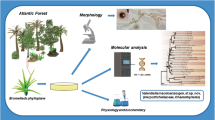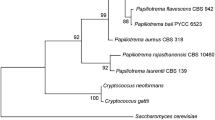Abstract
During a survey of unidentified yeast isolates deposited in the UNESCO-MIRCEN Biotechnological Yeast Culture Collection housed at the Department of Microbial, Biochemical and Food Biotechnology of the University of the Free State, one isolate obtained from soil in South Africa showed 100 % identity in D1/D2 rDNA sequence with undescribed basidiomycetous yeasts isolated from the gut of beetles from the United States of America and forest soil from Taiwan in the NCBI sequence database. Phylogenetic analyses using sequences of the D1/D2 rDNA and ITS regions indicated that all these isolates form a well-supported sub-clade that is the sister clade to the Brassicae plus Porosum clades of Trichosporon in the order Trichosporonales. Subsequent phenotypic tests revealed that asexual reproduction by budding is rare but dominated by arthroconidia resulting from segmentation of hyphae and that fusiform giant cells are characterized by budding from a broad base. These findings further suggest that these isolates belong to a single tremellomycetous yeast species for which the name Trichosporon vanderwaltii CBS 12124T (=NRRL Y-48732T, =UOFS Y-1920T) is proposed.


Similar content being viewed by others
References
Altschul SF, Gish W, Miller W, Myers EW, Lipman DJ (1990) Basic local alignment search tool. J Mol Biol 215:403–410
Boekhout T, Fonseca Á, Sampaio JP, Bandoni RJ, Fell JW, Kwon-Chung KJ (2011) Discussion of teleomorphic and anamorphic basidiomycetous yeasts. In: Kurtzman CP, Fell JW, Boekhout T (eds) The yeasts, a taxonomic study, 5th edn. Elsevier, Amsterdam, pp 1339–1374
Drummond AJ, Ashton B, Buxton S, Cheung M, Cooper A, Heled J, Kearse M, Moir R, Stones-Havas S, Sturrock S, Thierer T, Wilson A (2011) Geneious v5.5. Available from http://www.geneious.com. Accessed 11 April 2012
Fell JW, Scorzetti G (2004) Reassignment of the basidiomycetous yeasts Trichosporon pullulans to Guehomyces pullulans gen. nov., comb. nov. and Hyalodendron lignicola to Trichosporon lignicola comb. nov. Int J Syst Evol Microbiol 54:995–998
Fuentefria AM, Suh S-O, Landell MF, Faganello J, Schrank A, Vainstein MH, Blackwell M, Valente P (2008) Trichosporon insectorum sp. nov., a new anamorphic basidiomycetous killer yeast. Mycol Res 112:93–99
Guého E, Smith MTh, de Hoog GS (1998) Trichosporon Behrend. In: Kurtzman CP, Fell JW (eds) The yeasts, a taxonomic study, 4th edn. Elsevier, Amsterdam, pp 854–872
Gujjari P, Suh S-O, Lee C-F, Zhou JJ (2011) Trichosporon xylopini sp. nov., a hemicellulose-degrading yeast isolated from wood inhabiting beetle Xylopinus saperdioides. Int J Syst Evol Microbiol 61:2538–2542
Kurtzman CP, Robnett CJ (1998) Identification and phylogeny of ascomycetous yeasts from analysis of nuclear large subunit (26S) ribosomal DNA partial sequences. Antonie Van Leeuwenhoek 73:331–371
Kurtzman CP, Fell JW, Boekhout T, Robert V (2011) Methods for isolation, phenotypic characterization and maintenance of yeasts. In: Kurtzman CP, Fell JW, Boekhout T (eds) The yeasts, a taxonomic study, 5th edn. Elsevier, Amsterdam, pp 87–110
Larkin MA, Blackshields G, Brown NP, Chenna R, McGettigan PA, McWilliam H, Valentin F, Wallace IM, Wilm A, Lopez R, Thompson JD, Gibson TJ, Higgins DG (2007) Clustal W and Clustal X version 2.0. Bioinformatics 23:2947–2948
Margaritopoulos JT, Kasprowicz L, Malloch GL, Fenton B (2009) Tracking the global dispersal of a cosmopolitan insect pest, the peach potato aphid. BMC Ecol 9:13
Middelhoven WJ, Scorzetti G, Fell JW (2004) Systematics of the anamorphic basidiomycetous yeast genus Trichosporon Behrend with the description of five novel species: Trichosporon vadense, T. smithiae, T. dehoogii, T. scarabaeorum and T. gamsii. Int J Syst Evol Microbiol 54:975–986
Middlehoven WJ (2003) Identification of clinically relevant Trichosporon species. Mycoses 46:7–11
Middlehoven WJ (2004) Trichosporon wieringae sp. nov., an anamorphic basidiomycetous yeast from soil, and assimilation of some phenolic compounds, polysaccharides and other non-conventional carbon sources by saprophytic Trichosporon species. Antonie Van Leeuwenhoek 86:329–337
Okoli I, Oyeka CA, Kwon-Chung KJ, Theelen B, Robert V, Groenewald JZ, McFadden DC, Casadevall A, Boekhout T (2007) Cryptotrichosporon anacardii gen. nov., sp. nov., a new trichosporonoid capsulate basidiomycetous yeast from Nigeria that is able to form melanin on niger seed agar. FEMS Yeast Res 7:339–350
Pagnocca FC, Ruivo CCC, Forti LC, Legaspe MFC, Nagamoto NS, Rodrigues A, Bacci M Jr (2010) Yeasts isolated from a fungus-growing ant nest, including the description of Trichosporon chiarellii sp. nov., an anamorphic basidiomycetous yeast. Int J Syst Evol Microbiol 60:1454–1459
Scorzetti G, Fell JW, Fonseca A, Statzell-Tallman A (2002) Systematics of basidiomycetous yeasts: a comparison of large subunit D1/D2 and internal transcribed spacer rDNA regions. FEMS Yeast Res 2:495–517
Sugita T (2011) Trichosporon Behrend. In: Kurtzman CP, Fell JW, Boekhout T (eds) The yeasts, a taxonomic study, 5th edn. Elsevier, Amsterdam, pp 2015–2061
Sugita T, Nakase T (1998) Molecular phylogenetic study of the basidiomycetous anamorphic yeast genus Trichosporon and related taxa based on small subunit ribosomal DNA sequences. Mycoscience 39:7–13
Sugita T, Nishikawa A, Ichikawa T, Ikeda R, Shinoda T (2000) Isolation of Trichosporon asahii from environmental materials. Med Mycol 38:27–30
Suh S-O, Blackwell M (2004) Three new beetle-associated yeast species in the Pichia guilliermondii clade. FEMS Yeast Res 4:87–95
Suh S-O, McHugh JV, Pollock DD, Blackwell M (2005) The beetle gut: a hyperdiverse source of novel yeasts. Mycol Res 109:261–265
Takashima M, Sugita T, Shinoda T (2001) Reclassification of the Cryptococcus humicola complex. Int J Syst Evol Microbiol 51:2199–2210
Takashima M, Sugita T, Toriumi Y, Nakase T (2009) Cryptococcus tepidarius sp. nov., a thermotolerant yeast species isolated from a stream from a hot spring area in Japan. Int J Syst Evol Microbiol 59:181–185
Tamura K, Peterson D, Peterson N, Stecher G, Nei M, Kumar S (2011) MEGA 5: molecular evolutionary genetics analysis using maximum likelihood, evolutionary distance, and maximum parsimony methods. Mol Biol Evol 28:2731–2739
Thanh VN (2006) Lipomyces orientalis sp. nov., a yeast species isolated from soil in Vietnam. Int J Syst Evol Microbiol 56:2009–2013
Van der Walt JP, Yarrow D (1984) Methods for isolation, maintenance, classification and identification of yeasts. In: Kreger-van Rij NJW (ed) The yeasts, a taxonomic study, 3rd edn edn. Elsevier, Amsterdam, pp 45–101
Van Wyk PWJ, Wingfield MJ (1994) Ultrastructure of ascus arrangement and ascospore development in Ophiostoma seticolle. Mycologia 86:607–614
White TJ, Bruns T, Lee S, Taylor JW (1990) Amplification and direct sequencing of fungal ribosomal RNA genes for phylogenetics. In: Innis MA, Gelfand DH, Sninsky JJ, White TJ (eds) PCR protocols: a guide to methods and applications. Academic Press, San Diego, pp 315–322
Acknowledgments
This work of TEM, JA, JLFK and CHP was supported by the National Research Foundation and Department of Science and Technology under the SABI Programme (Grant Number 75048). Any opinion, findings and conclusions or recommendations expressed in this material are those of the authors and therefore the NRF and DST do not accept any liability in regard thereto. The contributions of MB and S-OS was supported by the US National Science Foundation (DEB-0072741and DEB-0417180) and the Boyd Professor Research Fund. We thank Hector Urbina, who revived the strains from beetles and Andri Van Wyk, who revived the South African strain.
Author information
Authors and Affiliations
Corresponding author
Rights and permissions
About this article
Cite this article
Motaung, T.E., Albertyn, J., Kock, J.L.F. et al. Trichosporon vanderwaltii sp. nov., an asexual basidiomycetous yeast isolated from soil and beetles. Antonie van Leeuwenhoek 103, 313–319 (2013). https://doi.org/10.1007/s10482-012-9811-2
Received:
Accepted:
Published:
Issue Date:
DOI: https://doi.org/10.1007/s10482-012-9811-2




